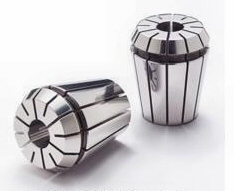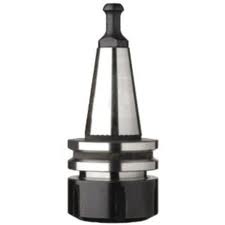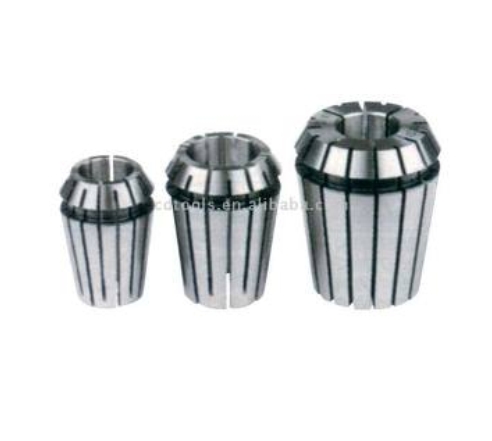Technical - Collets & Collet care
Collets have a life span of 3 months if used 8 hours a day. Replacing the collets will ensure that your operation runs consistently and prevents tool breakage. When inserting a tool into the collet, make sure the flute fade out does not enter the collet. If the collet is gripping on the fadeout, it will cause runout and potentially tool breakage. To ensure proper clamping the tool shank should fill, at a minimum, 80% of the depth of the collet.
Collets are subjected to very high stresses and wear and tear in everyday usage. They are consumable items and will need replacing from time to time. Every time you change a tool you should inspect the collet for out of round or bell mouthed conditions. Collet performance will also be affected by dirt, dust, bonding agents and scrap which affect the ability of the collet to properly clamp the tool.
You should also inspect the collet nut for damage or wear regularly. Excessive tool breakage and poor edge finish may be a result of collet wear causing incorrect tool holding.
Shop for collets.
Collet Choice
Collets should always be chosen so that they give the maximum amount of grip for the tool they are holding. Some collets, such as RDO style, come in fixed sizes so that if you have a 6mm tool you need a 6mm collet. If you have a 1/4" (6.35mm) tool, then you need a 1/4" collet.
Some ER style collets are also available in this way however, ER collets are more widely available to suit a range of shanks. For example, an ER32 6-7mm full grip collet will hold tools with shanks from 6mm to 7mm. An ER32 5-6mm collet will hold tools with shanks ranging from 5-6mm. To maximise grip within the collet, ER32 collets should always be chosen so that they do not have to be compressed too much to grip the tool shank. For this reason, a 5-6mm collet is best used for tools with a 6mm shank.
Collet Maintenance
Cleaning is an essential part of collet maintenance. As the material is cut, extremely fine dirt and resin migrate up the tool shaft into the collet, causing the collet, collet nut, tool holder and spindle interface to become dirty. This causes your tool to cut in an elliptical fashion which will decrease tool life and cause inconsistency in your operation. Keeping collets and tool holders clean is as essential as it is easy. You can obtain collet brush cleaning kits from our store to make the job easier.
Here are some simple pointers -
- Do not allow dirt to build up in the collet, cover nut or tool holder.
- Always clean mating surfaces prior to fitting.
- Do not use damaged collets, tools or tool holders.
- Do not leave tools or tool holders in spindles for extended periods of time. This can cause tools to be seized into the collet or tool holder.
|
Typical tool holder used in quick change spindles. |
Typical Cover nut |
Typical Collets |
There are a number of components that make up this critical tool holding system called a collet. A router bit can only be as good as the system that holds it properly. The small amount of time spent to regularly inspect and clean the collet system, will be more than offset by increased productivity and a reduction in overall costs.
Internal Collet Clamping Surfaces
The most important link in the tool holder chain is the inside of the collet. Resin migrates up through the slits in the collet and then deposits itself on the inside of the collet. This resin buildup, if not removed, causes the collet to grip inconsistently on the tool shank. By not applying equal pressure throughout the entire gripping range of the collet, the tool holder allows the tool to resonate inside, causing slippage inside the collet. Slippage can cause “fretting”, a condition in which resins are deposited on the shank of the tool. Any resin buildup should always be removed from the inside of the collet.
Internal Spindle & Collet Taper
The inside taper of the spindle and tool holder is a critical surface that accumulates resin buildup and should be cleaned at each tool change to maintain the best concentricity. Brushes are available to fit most taper sizes and provide a quick means of removing short-term buildup.
External Collet & Tool Holder Taper
The outside taper of the collet and tool holder require regular inspection and should be cleaned of all deposits each time the tool is changed. Brass brushes work well for this application.
Clamping Nut Surfaces
The inside of the nut should be clean and free of burrs on the surface. Any surface burrs or contamination will not only skew a collet but can also permanently ruin a new collet. The clamping nut should be cleaned with a brass brush during every tool change. Special care should be taken to examine the clamping nut threads on a regular basis. If a thread appears damaged or worn, the nut should be replaced immediately otherwise, you run the risk of the nut seizing or cross threading the thread on the tool holder or spindle shaft.
Tool Holders
Tool holders such as the ISO 30 have additional matching and mating tolerances beyond those of the older tapers. Because of their unique design, these tool-holding systems can be more prone to runout caused by resin buildup. “Fretting” or “Bronzing” will cause inconsistent gripping in the taper and/or the flat mating surface and reduce the consistency of tool life. If ignored, these conditions can eventually produce premature spindle failure. The mating surfaces should be cleaned regularly.
All of these components are critical and should be regularly maintained. One more item not to be overlooked is that collets should be replaced on a regular basis. This means inspection for metallic damage such as bell mouthing or burrs with every tool change. If damage is visible, the collet should be discarded and replaced.
Also, consider that even if there is no damage present the collet can be worn out through metal fatigue. Heat is directly transferred from the tool to the collet. These heating/cooling cycles remove the original tempering of the steel. Collets are made from spring steel allowing them to have a certain amount of elasticity to grip the tool. As the heat cycle is repeated this elasticity diminishes. Over time, a collet requires increased tightening to maintain the tool in the proper position. As over tightening increases, the collet is distorted, creating eccentricities in the tool holder. Therefore, instead of over tightening older collets and creating a number of other problems, the collet should be replaced. Often the cost of a new collet can be offset by the cost of needlessly broken tools in one shift alone.





